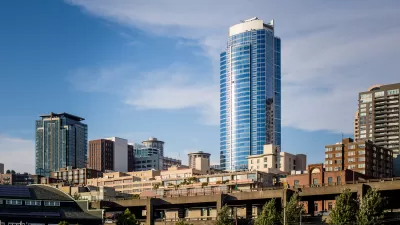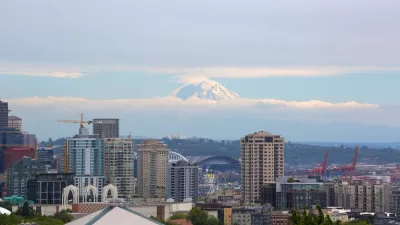To preserve views, zoning rules from 2006 require adequate distance between residential towers of a certain height. As developers chafe against the restriction, residents still worry they'll be left facing a wall.

Another symptom of Seattle's success: limited access to a decent view. Condos boasting picture-window vistas a decade ago lose their allure when an even taller residential tower goes up 20 feet away.
Seattle has taken steps to prevent that from happening. "The city's tower-spacing rule, which governs a large swath of downtown, was adopted nearly a decade ago to preserve views and daylight in an increasingly dense downtown [...] When the city overhauled the zoning code in 2006, it allowed developers to build denser, higher towers in downtown's mixed-use areas."
"To prevent streets from becoming walled corridors that block out light and views, and make pedestrians feel like they're in a wind tunnel, the city required that new towers over 160 feet high be 60 to 200 feet away, depending on the part of downtown, from other existing or permitted ones." Unfortunately, or fortunately, depending on how you look at it, this rule puts adjacent developers into competition for the permit to build higher. "Even small delays by either side can lead to being second in line for a tower permit and huge lost opportunities [...]"
Still, the tower-spacing rule enjoys public support. "Some residents of other downtown areas where the tower-spacing rules don't apply wish they had such restrictions. They say they live in fear of having a tower built a stone's throw from their window." To address those fears, some developers are experimenting with the podium-style developments (wide base, often with retail, and a thin, glassy tower on top) that have seen success in Vancouver.
FULL STORY: Rules preserving city views set up clash among towers competing to be first, biggest

Pennsylvania Mall Conversion Bill Passes House
If passed, the bill would promote the adaptive reuse of defunct commercial buildings.

Planning for Accessibility: Proximity is More Important than Mobility
Accessibility-based planning minimizes the distance that people must travel to reach desired services and activities. Measured this way, increased density can provide more total benefits than increased speeds.

World's Largest Wildlife Overpass In the Works in Los Angeles County
Caltrans will soon close half of the 101 Freeway in order to continue construction of the Wallis Annenberg Wildlife Crossing near Agoura Hills in Los Angeles County.

Eviction Looms for Low-Income Tenants as Rent Debt Rises
Nonprofit housing operators across the country face almost $10 billion in rent debt.

Brightline West Breaks Ground
The high-speed rail line will link Las Vegas and the Los Angeles area.

Colorado Bans No-Fault Evictions
In most cases, landlords must provide a just cause for evicting tenants.
City of Costa Mesa
Licking County
Barrett Planning Group LLC
HUD's Office of Policy Development and Research
Mpact Transit + Community
HUD's Office of Policy Development and Research
Tufts University, Department of Urban and Environmental Policy & Planning
City of Universal City TX
ULI Northwest Arkansas
Urban Design for Planners 1: Software Tools
This six-course series explores essential urban design concepts using open source software and equips planners with the tools they need to participate fully in the urban design process.
Planning for Universal Design
Learn the tools for implementing Universal Design in planning regulations.

























